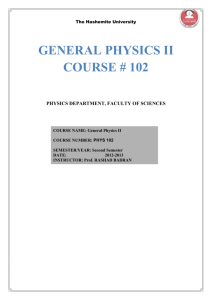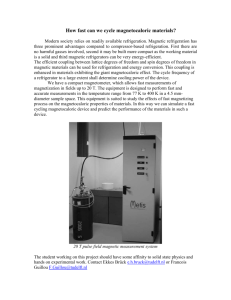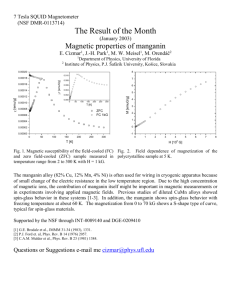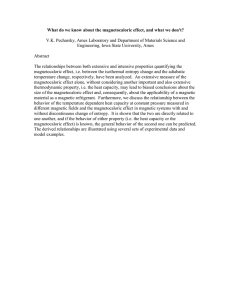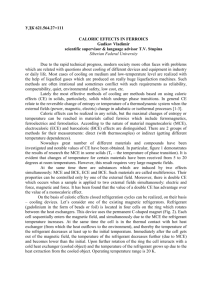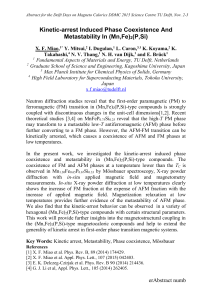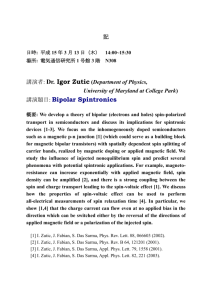View
advertisement
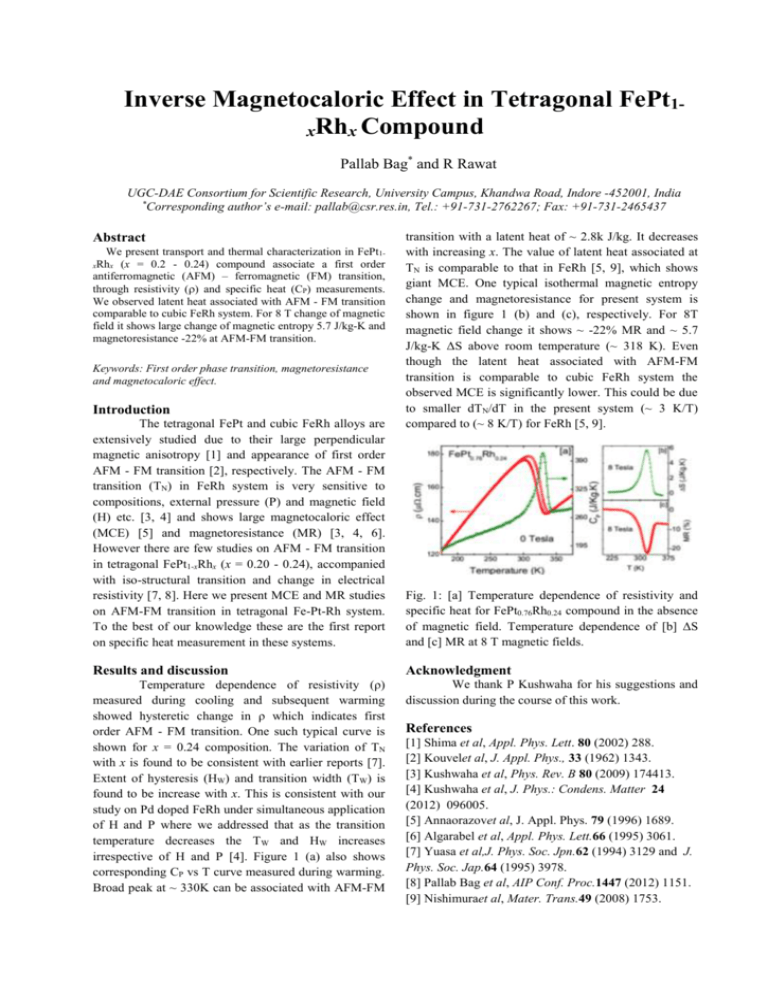
Inverse Magnetocaloric Effect in Tetragonal FePt1xRhx Compound Pallab Bag* and R Rawat UGC-DAE Consortium for Scientific Research, University Campus, Khandwa Road, Indore -452001, India * Corresponding author’s e-mail: pallab@csr.res.in, Tel.: +91-731-2762267; Fax: +91-731-2465437 Abstract We present transport and thermal characterization in FePt1(x = 0.2 - 0.24) compound associate a first order antiferromagnetic (AFM) – ferromagnetic (FM) transition, through resistivity () and specific heat (CP) measurements. We observed latent heat associated with AFM - FM transition comparable to cubic FeRh system. For 8 T change of magnetic field it shows large change of magnetic entropy 5.7 J/kg-K and magnetoresistance -22% at AFM-FM transition. xRhx Keywords: First order phase transition, magnetoresistance and magnetocaloric effect. Introduction The tetragonal FePt and cubic FeRh alloys are extensively studied due to their large perpendicular magnetic anisotropy [1] and appearance of first order AFM - FM transition [2], respectively. The AFM - FM transition (TN) in FeRh system is very sensitive to compositions, external pressure (P) and magnetic field (H) etc. [3, 4] and shows large magnetocaloric effect (MCE) [5] and magnetoresistance (MR) [3, 4, 6]. However there are few studies on AFM - FM transition in tetragonal FePt1-xRhx (x = 0.20 - 0.24), accompanied with iso-structural transition and change in electrical resistivity [7, 8]. Here we present MCE and MR studies on AFM-FM transition in tetragonal Fe-Pt-Rh system. To the best of our knowledge these are the first report on specific heat measurement in these systems. transition with a latent heat of ~ 2.8k J/kg. It decreases with increasing x. The value of latent heat associated at TN is comparable to that in FeRh [5, 9], which shows giant MCE. One typical isothermal magnetic entropy change and magnetoresistance for present system is shown in figure 1 (b) and (c), respectively. For 8T magnetic field change it shows ~ -22% MR and ~ 5.7 J/kg-K ΔS above room temperature (~ 318 K). Even though the latent heat associated with AFM-FM transition is comparable to cubic FeRh system the observed MCE is significantly lower. This could be due to smaller dTN/dT in the present system (~ 3 K/T) compared to (~ 8 K/T) for FeRh [5, 9]. Fig. 1: [a] Temperature dependence of resistivity and specific heat for FePt0.76Rh0.24 compound in the absence of magnetic field. Temperature dependence of [b] ΔS and [c] MR at 8 T magnetic fields. Results and discussion Acknowledgment Temperature dependence of resistivity (ρ) measured during cooling and subsequent warming showed hysteretic change in ρ which indicates first order AFM - FM transition. One such typical curve is shown for x = 0.24 composition. The variation of TN with x is found to be consistent with earlier reports [7]. Extent of hysteresis (HW) and transition width (TW) is found to be increase with x. This is consistent with our study on Pd doped FeRh under simultaneous application of H and P where we addressed that as the transition temperature decreases the TW and HW increases irrespective of H and P [4]. Figure 1 (a) also shows corresponding CP vs T curve measured during warming. Broad peak at ~ 330K can be associated with AFM-FM We thank P Kushwaha for his suggestions and discussion during the course of this work. References [1] Shima et al, Appl. Phys. Lett. 80 (2002) 288. [2] Kouvelet al, J. Appl. Phys., 33 (1962) 1343. [3] Kushwaha et al, Phys. Rev. B 80 (2009) 174413. [4] Kushwaha et al, J. Phys.: Condens. Matter 24 (2012) 096005. [5] Annaorazovet al, J. Appl. Phys. 79 (1996) 1689. [6] Algarabel et al, Appl. Phys. Lett.66 (1995) 3061. [7] Yuasa et al,J. Phys. Soc. Jpn.62 (1994) 3129 and J. Phys. Soc. Jap.64 (1995) 3978. [8] Pallab Bag et al, AIP Conf. Proc.1447 (2012) 1151. [9] Nishimuraet al, Mater. Trans.49 (2008) 1753.


